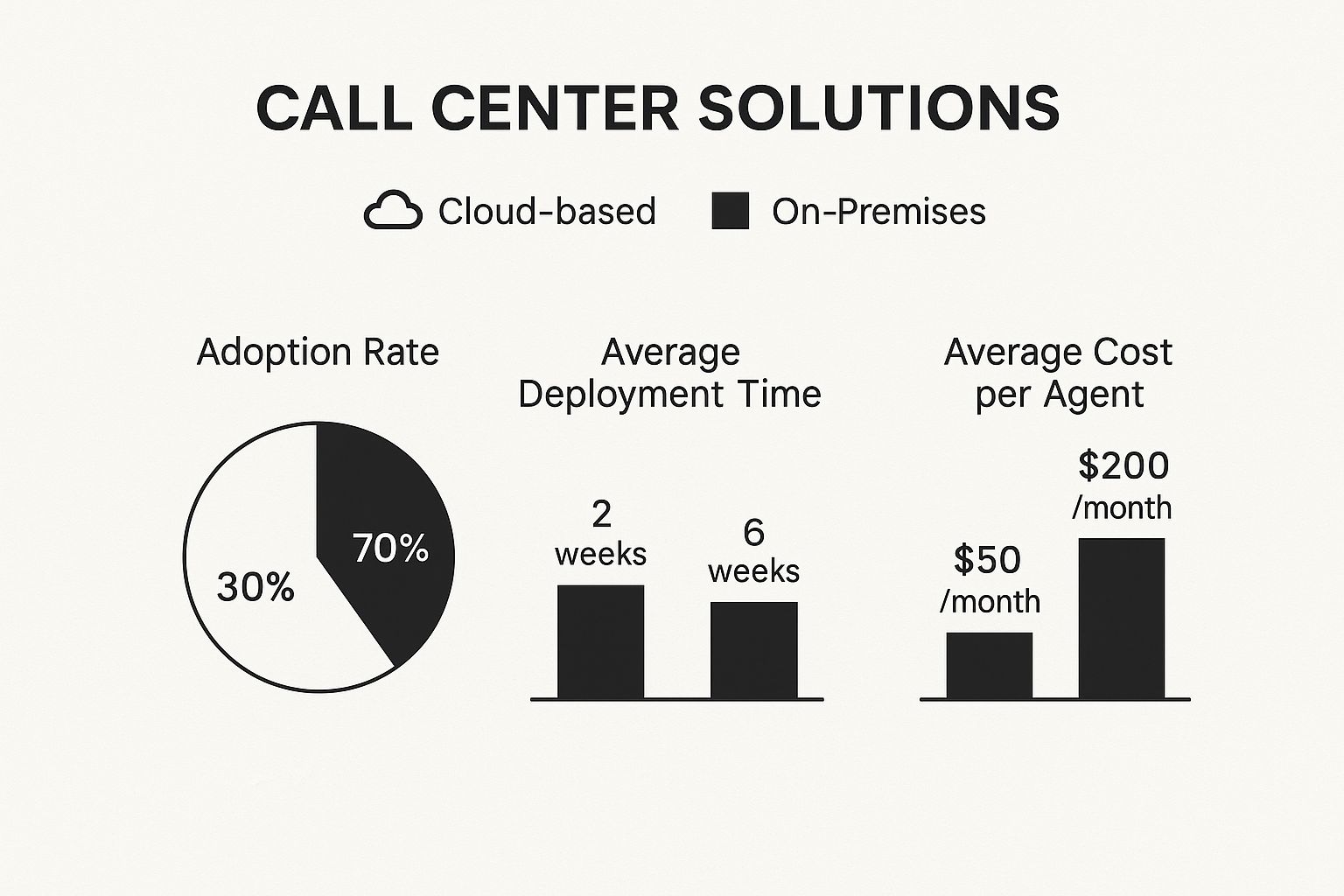Let’s cut through the jargon. At its core, an inbound call center is simply a team dedicated to handling incoming phone calls from your customers and prospects. Think of it as your business’s digital front door—the first point of human contact for anyone reaching out for help.

Here’s a better way to picture it: Imagine your business is a busy airport. An inbound call center is your air traffic control tower, expertly managing every single incoming communication.
Each call is like a plane looking for a safe landing. It could be a frustrated customer with a technical glitch, a curious buyer with questions about a product, or an existing client needing to update their account details. The call center’s job is to guide each one to the right destination—the correct agent or department—without any turbulence.
This system is so much more than an old-school switchboard operator patching calls through. A modern call center is a strategic asset designed to create positive, productive interactions from the moment an agent says hello. Its real purpose is to solve problems, answer questions, and build a foundation of trust with your audience.
Fueled by new tech and sky-high customer expectations, the inbound call center industry has exploded. We’re talking about a massive global operation. In 2023, there were roughly 17 million contact center agents worldwide, with a huge chunk of them focused purely on handling inbound customer needs. You can dig into more contact center benchmarks to see just how much the industry is changing.
To give you a clearer picture, here’s a quick breakdown of what these teams spend their time on.
This table sums up the primary jobs an inbound call center handles, showing how each one directly supports key business objectives.
Ultimately, these core functions work together to create a support system that customers can rely on.
At its heart, an inbound call center is more than a cost center; it's a value generator. Every resolved ticket and every positive interaction strengthens customer loyalty and protects your brand's reputation. It transforms reactive problem-solving into proactive relationship-building.
Think of an inbound call center as more than just a bank of phones. It's a powerful engine for growing your business. It takes a basic function—customer service—and turns it into a strategic asset that builds your brand, deepens customer relationships, and puts money back on your bottom line. This is where you transform everyday interactions into real opportunities.
When a customer calls with a problem, they're usually frustrated. Being able to offer instant, professional support through a dedicated call center can flip that negative experience into a positive one. This simple act of solving a problem efficiently is one of the quickest ways to build loyalty. Studies show that customers are far more likely to stick with a company that resolves their issues quickly, giving a direct boost to customer retention rates.
For a long time, call centers were seen as just another necessary expense. But the modern inbound call center is a goldmine of revenue and insight. Every single call is a chance to understand your customers on a deeper level, pinpoint their frustrations, and uncover new opportunities you might have missed.
By centralizing all these conversations, you create a consistent, reliable brand experience. This consistency makes your business feel more established and trustworthy. Instead of calls going to a personal cell phone or a busy staff member juggling other tasks, they’re handled by a system built for professionalism from the ground up.
An inbound call center acts as your brand's frontline ambassador. It ensures every customer feels heard, valued, and respected, turning routine service calls into powerful moments of brand reinforcement that drive long-term loyalty and repeat business.
Beyond the customer-facing perks, an inbound call center brings major improvements to your operations. It streamlines everything by routing callers to the right person or department automatically, which slashes response times and gets rid of confusion. This frees up your core team to focus on their actual jobs instead of being constantly derailed by a ringing phone.
Optimizing your operations with tools like digital workflow automation can seriously level up a call center's ability to handle more calls while improving customer satisfaction. When you automate the routine stuff and get your systems talking to each other, you can achieve a lot more with less effort.
Here’s a quick look at how an inbound call center tightens up your operational flow:
Ultimately, this operational polish doesn’t just save you time and money. It captures priceless insights from every customer conversation, giving you the information you need to make smarter business decisions and fuel sustainable growth.

If you peek behind the curtain of a high-performing inbound call center, you won't just find people on phones. You'll see a sophisticated collection of technology, all working together to manage calls, empower agents, and get customers what they need—fast. This digital backbone is what elevates a simple answering service into a genuine customer experience hub.
At the very heart of this operation is the Automatic Call Distribution (ACD) system. Think of it as an incredibly smart traffic cop for your phone lines. When a call comes in, the ACD instantly figures out the best place for it to go based on rules you set, like the number dialed or the caller's area code. It then routes the call to the perfect agent or department, making sure customers get to the right person on the first try. That alone slashes frustration and cuts down on those dreaded transfer times.
Working hand-in-hand with the ACD is the Interactive Voice Response (IVR) system. This is the automated menu you hear when you call a company ("For sales, press one..."). But modern IVRs are much more than just call directors. They now offer powerful self-service options, letting customers check an order status, pay a bill, or find answers to simple questions without ever needing to speak to a person.
This kind of automation is a huge win for everyone. Customers get the answers they need instantly, any time of day, and your agents are freed up to focus on the more complex problems that actually require a human touch.
An inbound call center's technology isn't just about efficiency; it's about control. By automating routine tasks and intelligently routing complex ones, you give both customers and agents a clearer, faster path to resolution.
Artificial intelligence is completely changing the game for inbound call centers. The growth here is explosive; the market for call center AI is expected to jump from $1.6 billion in 2022 to a staggering $4.1 billion by 2027. This boom is all about AI's ability to handle queries on its own and give agents real-time support.
A few key AI tools are leading the charge:
Finally, great technology pulls all your customer information into one, easy-to-use place. One of the most fundamental tools for this is Computer Telephony Integration (CTI), which acts as the bridge connecting your phone system to your computer systems.
When a call comes in, CTI talks to your Customer Relationship Management (CRM) software and instantly pops the caller's entire history onto the agent's screen. We're talking past purchases, old support tickets, contact info—everything. Armed with this 360-degree view, agents can skip the repetitive "Can I get your account number?" questions and provide personalized support that makes customers feel like you actually know them.
Figuring out how to set up your inbound call center is a huge decision, one that will stick with you for the long haul. There’s no magic bullet here—the right answer really depends on your budget, your goals, and just how much control you want to keep. Picking the wrong model can burn through cash, while the right one can become the engine for your growth.
You've basically got three roads you can take: build a team in-house, outsource the whole thing to another company, or go with a flexible cloud-based system. Each one comes with its own set of pros and cons around cost, your ability to scale, and how much you have to manage day-to-day.
An in-house team gives you total control over training, brand voice, and quality. But it's also a big investment upfront—you're on the hook for hiring, tech, and even the physical office space. On the flip side, outsourcing can be a super cost-effective way to get 24/7 coverage without all that overhead.
Outsourcing is a popular route because it lets you plug into specialized expertise and infrastructure right away. The global market for contact center outsourcing is massive. In fact, Asia Pacific commands over 23% market share in 2024, offering incredible scale for handling call volumes. Meanwhile, the United States is seeing its own steady growth at a 7.2% CAGR from 2019 to 2024, showing a strong domestic appetite for these service technologies. You can dive deeper into these call center statistics and trends to get a better feel for the market.
Then there's the third option, which is getting more popular by the day: the cloud-based model. This virtual approach can feel like the best of both worlds. You get affordability and the power to scale up or down without needing a single piece of hardware in your office. It lets your team work from anywhere and gives you access to powerful features that used to be only for the big players, all for a simple subscription.
The big takeaway here is that a "call center" isn't a room full of desks anymore. The real decision is about balancing control with flexibility and cost. That’s why cloud solutions are hitting the sweet spot for so many growing businesses.
This infographic breaks down some of the key differences between cloud-based and old-school on-premises setups.

The numbers don't lie. Cloud-based systems are not only the more popular choice, but they're also way faster and cheaper to get up and running.
To make things a bit clearer, let's break down how these three models stack up against each other. Each one has its place, but seeing them side-by-side can really help pinpoint which one aligns with your business's current needs and future ambitions.
Ultimately, the best choice isn't about which model is "better" in a vacuum, but which one is the perfect puzzle piece for your specific situation.
So, how do you make the final call? It boils down to being honest about your priorities. Ask yourself these questions:
Answering these will point you toward the model that truly fits your business strategy. Get this right, and your inbound call center won't just be a department—it'll be a genuine asset that drives your business forward.

Getting your inbound call center up and running is just the first lap. To really pull ahead, you need a strategy built around constant improvement. It’s all about moving beyond the basics and adopting habits that boost both efficiency and the customer experience.
The heart of a great call center isn’t the tech—it’s the people. Your best investment will always be in comprehensive agent training that goes way beyond just reading from a script. Of course, you need to arm your team with deep product knowledge, but the real magic happens when you train them in empathy, active listening, and creative problem-solving.
An agent who can genuinely understand a customer's frustration and figure out a real solution is infinitely more valuable than one who just robotically follows a flowchart. This human-first approach is what turns a routine support call into a memorable, positive moment for your brand.
To know if you're winning, you have to keep score with the right metrics. While speed is a factor, an obsession with call duration can just push agents to rush customers off the line. Instead, you'll want to prioritize Key Performance Indicators (KPIs) that actually reflect the quality of the customer’s experience.
First Call Resolution (FCR): This is the gold standard. FCR tracks the percentage of calls where the customer's issue is totally solved on the first try, so they don't have to call back. A high FCR is a direct sign of skilled agents and happy customers.
Customer Satisfaction (CSAT): The easiest way to know if customers are happy is to ask them. A simple post-call survey ("On a scale of 1-5, how satisfied were you?") gives you a direct line into how your team is performing from the only perspective that matters: the customer's.
The goal isn't just to answer calls faster; it's to solve problems better. Shifting your focus from Average Handle Time to First Call Resolution fundamentally changes your team's objective from speed to effectiveness, leading to genuinely happier customers.
Your call recordings and analytics reports are a goldmine for coaching opportunities. Don't just file them away for compliance—put them to work. Sit down with your agents and review calls together, not to criticize, but to coach. Point out what they did well and gently identify areas for improvement.
This data-driven feedback loop is how you turn good agents into great ones. Speed is still a critical piece of the puzzle; industry benchmarks show about 80% of inbound calls in US call centers are answered within 20 seconds. Many are now even aiming to answer 90% within 15 seconds to keep up with rising expectations.
You can dig into more key call center statistics to see how you measure up. By using your analytics, you can fine-tune your operations to hit those speed targets while making sure every single interaction builds trust and strengthens your customer relationships.
An inbound call center should never be a lonely island. Its real power gets unlocked when it acts as the central nervous system for all your customer communications, plugged into every other tool in your business. When these systems are talking to each other, you build a unified ecosystem that smooths out the rough edges and builds much stronger customer relationships.
The absolute most critical connection is with your Customer Relationship Management (CRM) software. When your call center and CRM are synced up, your agents see a customer's entire history the second their call comes in. We’re talking past purchases, previous support tickets, and any notes left by other team members.
This integration gives your team a complete, 360-degree view of the customer. Instead of starting every single conversation from square one, agents can jump right in with personalized, super-efficient support. They can see a customer just bought a certain product or has been struggling with a recurring issue, letting them solve problems way faster and with the right context.
Beyond the CRM, a few other integrations are just as important for creating that smooth journey:
A connected inbound call center shifts customer service from a string of separate, one-off interactions into a continuous, intelligent conversation. Data flows freely, empowering every department to deliver a consistent experience that makes customers feel genuinely known and valued.
This is the kind of integration that separates a basic answering service from a true strategic asset. It ensures every customer interaction is informed by the last one, creating a connected experience that builds the kind of loyalty that lasts.
Of course. Here is the rewritten section, crafted to sound completely human-written, following the style and tone of the provided examples.
Even after getting the basics down, you probably have a few specific questions floating around. That’s perfectly normal. Let's dig into some of the most common ones I hear from business owners just like you.
It all comes down to who makes the first move.
Think of an inbound call center as your welcome mat. The customer has a reason to reach out—they need help with a product, want to ask a question, or are ready to buy—so they call you. They're initiating the conversation.
An outbound call center is the complete opposite. Your team is the one picking up the phone to make the first move. They're calling potential customers for sales, following up on leads, or conducting surveys.
So, inbound is all about reacting to customer needs, while outbound is about proactively creating new opportunities.
At its heart, an inbound center is there to solve problems and deliver immediate value, which is a powerhouse for building customer loyalty. Outbound, on the other hand, is built to generate leads and drive new business from scratch.
Yes, without a doubt. The old image of a call center—rows of agents in a giant, expensive office—is completely outdated. Thanks to modern cloud technology, professional inbound call services are more accessible and affordable than ever.
You no longer have to worry about buying bulky servers or pricey hardware. Today's solutions run on a subscription model, often called Contact Center as a Service (CCaaS). You just pay a predictable monthly fee per user, which gives you all the powerful, enterprise-grade features without the massive upfront cost.
You measure what matters. Success isn't just about answering calls; it's about tracking specific Key Performance Indicators (KPIs) that tell you how efficient and effective your team is.
For an inbound center, you'll want to keep a close eye on these three metrics:
Ready to see how an AI-powered inbound system can transform your customer service? My AI Front Desk offers an intelligent AI receptionist that handles calls, books appointments, and provides instant support 24/7, so you never miss a lead. Learn more at myaifrontdesk.com.
Start your free trial for My AI Front Desk today, it takes minutes to setup!








